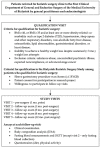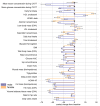Sex-Specific Glucose Homeostasis and Anthropometric Responses to Sleeve Gastrectomy in Obese Patients
- PMID: 31600929
- PMCID: PMC6836106
- DOI: 10.3390/nu11102408
Sex-Specific Glucose Homeostasis and Anthropometric Responses to Sleeve Gastrectomy in Obese Patients
Abstract
Bariatric surgery rapidly and effectively treats obesity and its comorbidities like dysregulated glucose homeostasis. Despite the sex-balanced incidence of obesity in most human populations, women have sought this intervention more frequently than men. However, as the number of bariatric surgeries rapidly rises, it is increasingly urgent to understand how sex-specific differences may emerge in metabolic and anthropometric parameters. Hundred fifty-four obese patients (47% men and 53% women) from the Bialystok Bariatric Surgery Study underwent sleeve gastrectomy and were measured for 25 parameters at baseline (immediately prior to surgery) and at four follow-up visits over one year. We used generalized linear mixed models to detect sex-specific differences in the time series of responses parameters. Unlike most previous studies with older cross-sections of men than women, our cohort was age-matched, and men were less healthy at baseline. Of parameters that showed a significant cohort-wide (across-sex) response, 14 (56%) also showed sex-specific responses with men improving more than women. In particular, men remitted in diabetes symptoms more strongly, rapidly, and durably than women. Taken together, our results indicate that men may benefit more from sleeve gastrectomy and that this difference in improvement may be related to more progressed morbidity prior to surgery independent of age.
Keywords: bariatric surgery; diabetes; gender; glucose homeostasis; sex; sleeve gastrectomy.
Conflict of interest statement
The authors declare no conflict of interest.
Figures





References
-
- WHO . Obesity and Overweight: Fact Sheet. WHO; Geneva, Switzerland: 2018. [(accessed on 3 August 2019)]. Available online: https://www.who.int/news-room/fact-sheets/detail/obesity-and-overweight.
-
- English W.J., DeMaria E.J., Brethauer S.A., Mattar S.G., Rosenthal R.J., Morton J.M. American Society for Metabolic and Bariatric Surgery estimation of metabolic and bariatric procedures performed in the United States in 2016. Surg. Obes. Relat. Dis. 2018;14:259–263. doi: 10.1016/j.soard.2017.12.013. - DOI - PubMed
Publication types
MeSH terms
Substances
Grants and funding
LinkOut - more resources
Full Text Sources
Medical

